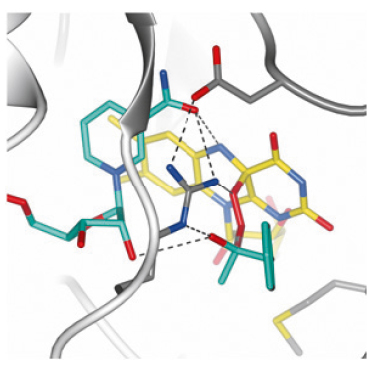- Home
- Users & Science
- Scientific Documentation
- ESRF Highlights
- ESRF Highlights 2011
- Structural biology
- Structural and spectroscopic observation of an enzyme at work
Structural and spectroscopic observation of an enzyme at work
At the end of the 19th century, Baeyer and Villiger discovered that cyclic ketones react with oxidants such as peroxymonosulphuric acid to yield lactones. Baeyer-Villiger reactions are of enormous value in synthetic organic chemistry and the number of their applications is countless. Several microorganisms produce enzymes able to catalyse Baeyer-Villiger reactions. Amongst these, Baeyer-Villiger monooxygenases are FAD-dependent proteins that use NADPH and molecular oxygen to insert an oxygen atom into their substrate. In this context, it must be emphasised that oxygen biocatalysis and regulation is crucial to a variety of biochemical processes in Nature. Despite extraordinary research progress, the structural and biochemical determinants of specific and efficient oxygen reactivity remain poorly understood [1]. In recent years, we have identified a microbial Baeyer-Villiger enzyme, phenylacetone monooxygenase, which offers several unique and attractive features: it is thermostable, tolerant towards organic solvents, and catalyses enantioselective Baeyer-Villiger oxidations and sulfoxidations. We were able to generate several intermediate states of this coloured enzyme and to characterise them by X-ray crystallography and single-crystal microspectrophotometry both at the synchrotron beamline (ID14-1, online) and at the dedicated Cryobench laboratory (ID29S, offline [2]).
 |
|
Fig. 118: Microspectrophotometry of PAMO crystals (inset) measured at 100 K. X-ray exposure of the crystals leads to the reduction of the flavin moiety (spectrum A, bold line and inset). Reduced crystals can then be re-oxidised by soaking at room-temperature in aerated solutions as shown by spectra B, C, D which were collected from crystals that were cryo-cooled 2, 4, and 6 minutes after starting the re-oxidation process. |
The experimental strategy recruited otherwise detrimental X-ray induced changes to biomolecules to trigger reduction of the X-ray sensitive flavin moiety of phenylacetone monooxygenase (Figure 118). The resulting intermediate state was captured and structurally characterised by X-ray crystallograpy using diffraction data collected at 100K. These studies highlight the fascinating ability of Baeyer-Villiger monooxygenases to catalyse a complex, multi-step catalytic reaction. The reaction includes the concerted action of two cofactors (NADPH and FAD) and the protein active site to subsequently promote flavin reduction, oxygen activation, tetrahedral intermediate formation (Figure 119), and product synthesis and release.
 |
|
Fig. 119: Three-dimensional structural model of the crucial oxygenating “Criegee” intermediate of phenylacetone monooxygenase (PAMO). |
The emerging picture is that these enzymes are mainly oxygen-activating “Criegee-stabilising” catalysts that act on any chemically suitable substrate that can diffuse into the active site. This emphasises their potential value as toolboxes for biocatalytic applications.
A movie related to this research is available at www.unipv.it/biocry.
Principal publication and authors
R. Orru (a), H.M. Dudek (b), C. Martinoli (a), D.E. Torres Pazmino (b), A. Royant (c,d), M. Weik (c,d), M.W. Fraaije (b) and A. Mattevi (a), J. Biol. Chem. 286, 29284 (2011).
(a) University of Pavia (Italy)
(b) University of Groningen (The Netherlands)
(c) Institut de Biologie Structurale, Grenoble (France)
(d) ESRF
References
[1] R. Baron, J.A. McCammon and A. Mattevi, Curr. Opin. Struct. Biol. 19, 672-679 (2009).
[2] J. McGeehan, R.B. Ravelli, J.W. Murray, R.L. Owen, F. Cipriani, S. McSweeney, M. Weik and E.F. Garman, J. Synchrotron Radiat. 16, 163-172 (2009).
Acknowledgements
This research is part of a more comprehensive effort aimed at exploiting Baeyer-Villiger enzymes for applications in industrial biocatalysis and green chemistry within the framework of a project “Oxygreen”, supported by the EU-FP7.



